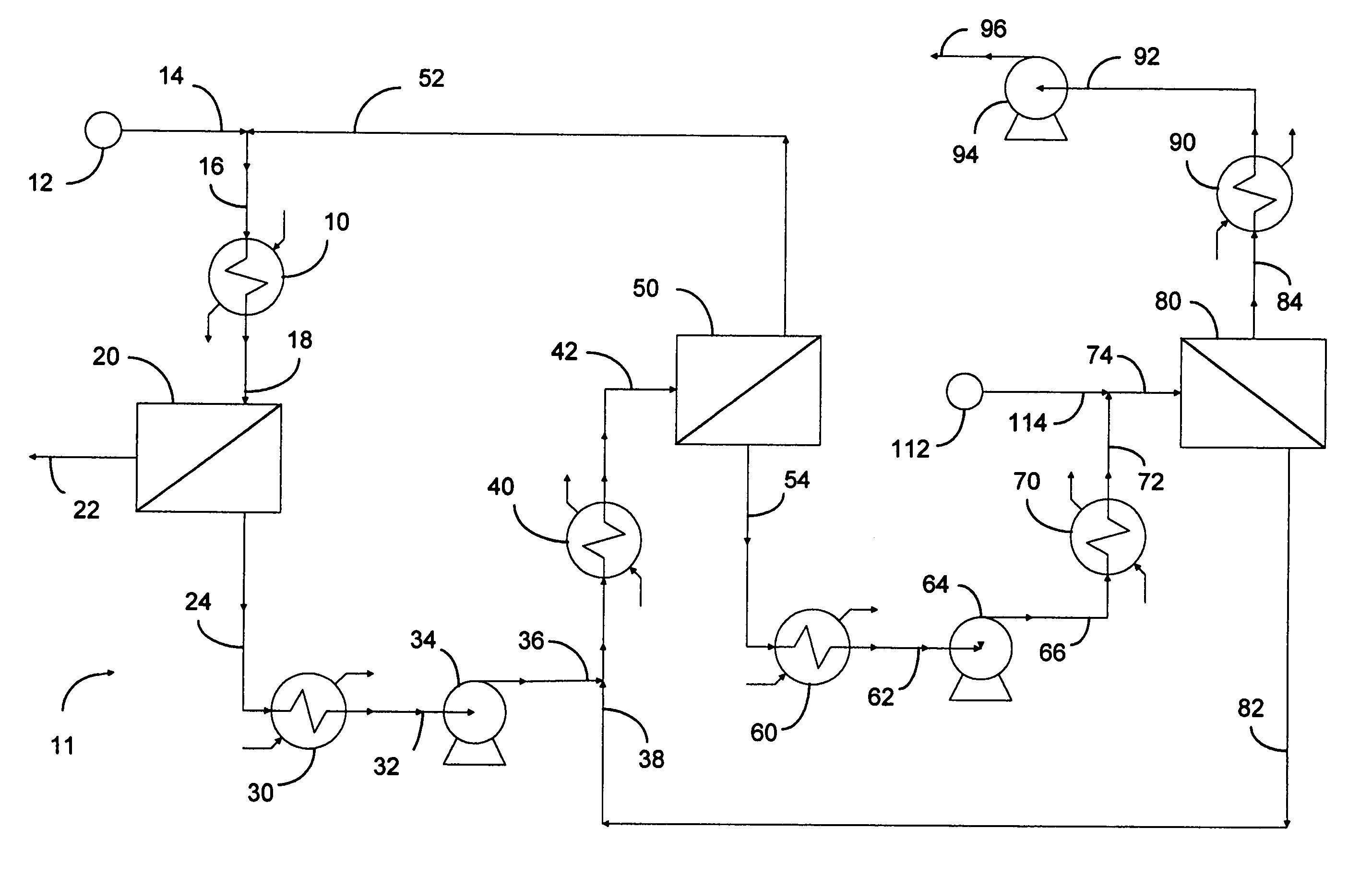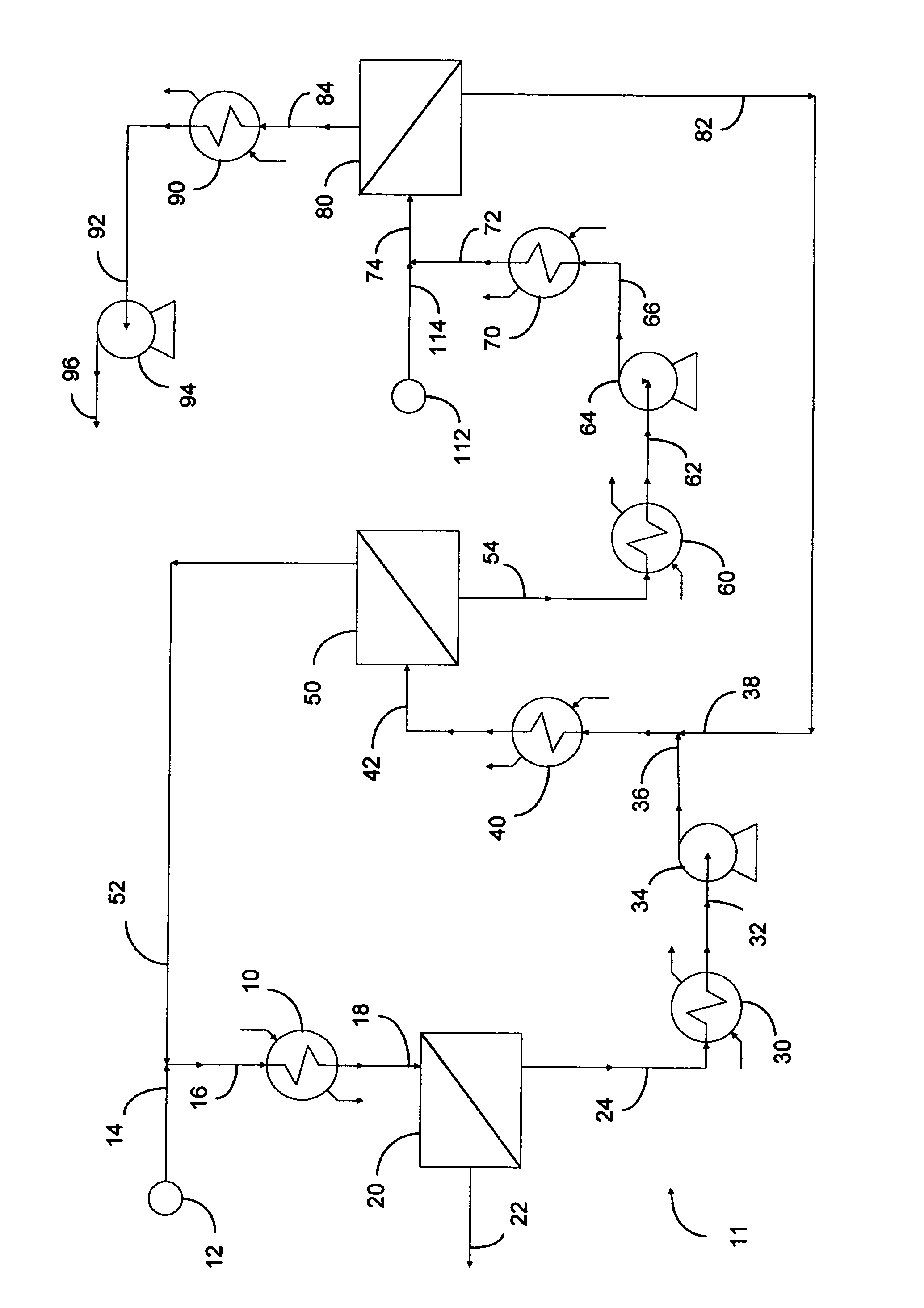Selective separation of fluid compounds utilizing a membrane separation process
a technology of membrane separation and fluid compounds, which is applied in the direction of separation processes, hydrocarbon oil treatment products, liquid degasification, etc., can solve the problems of large number of separation, inherently expensive separation methods, and small practicable and theoretical enrichments achievable by this technique, so as to reduce capital, operating and energy costs, cost prohibitive
- Summary
- Abstract
- Description
- Claims
- Application Information
AI Technical Summary
Benefits of technology
Problems solved by technology
Method used
Image
Examples
example 1
[0047]The apparatus consisting of only module 20 as shown in the drawing was simulated using a para-xylene selectivity of 50 and para-xylene permeability of 5 Barrer. The fluid in conduit 18 was fed to the membrane module at 300° F. (at approximately 18 psia). The amount of area employed in membrane module 20 was varied and the feed pressure was adjusted at the same time so that the MEI was 1 for fluid in conduit 22. Results are shown in Table I.
[0048]
TABLE IMembrane Performance with MEI = 1.0Permeate PXPermeate PXMembraneMembraneContentRecoveryFeed VaporArea(percent by(percent byMolar(×10−3 ft2)weight)weight)MEIFraction30089631.00.0339087781.00.1265081931.00.22
[0049]The results in Table I show that as permeate recovery increased permeate purity decreased. At the same time, more material passed through the membrane and membrane cooling increased as membrane area increased. As membrane cooling increased, it was necessary to further vaporize the feed in order to maintain a MEI of one....
example 2
[0052]This example documents effects of nonpermeate subcooling on membrane performance. Calculations were performed in this example with the same membrane areas employed in Example 1 while the membrane feed vapor fraction was maintained at 0.02. Para-xylene selectivity of 50, para-xylene permeability of 5 Barrer, and a 300° F. membrane feed temperature was again used.
[0053]In this example, the membrane is operating both in vapor permeation and pervaporation mode. Results shown in Table II indicate that as the membrane area increased subcooling of the nonpermeate also increased. Hence permeate recoveries were not as high as in Example 1 because membrane subcooling lowers the permeation driving force. This shows the advantages of operating the membrane so that significant subcooling does not occur.
[0054]
TABLE IIMembrane Performance with Feed Vapor Fraction of 0.02Permeate PXPermeate PXMembraneContentRecoveryNonpermeateArea(percent by(percent bySubcooling(×10−3 ft2)weight)weight)MEI(° ...
example 3
[0055]This example documents effects of heating the membrane feed so that the nonpermeate is a vapor-liquid mixture. Calculations were again performed with the same membrane areas employed in Example 1, but in this example the membrane feed vapor fraction was maintained at 0.3. Para-xylene selectivity of 50, para-xylene permeability of 5 Barrer, and 300° F. membrane feed temperature was again used.
[0056]Results of these calculations are shown in Table III. As membrane area increased, permeate recovery and membrane cooling increased. Consequently, the vapor content of the nonpermeate also decreased. If necessary, a cooler would need to be employed to completely condense the nonpermeate before it could be pressurized with a pump. However, this would lead to additional equipment and energy costs. The results shown in Table III show that the permeate recoveries in this example were better than Example 1 because the driving force was higher in this example.
[0057]
TABLE IIIMembrane Perform...
PUM
| Property | Measurement | Unit |
|---|---|---|
| outer diameter | aaaaa | aaaaa |
| permeate pressure | aaaaa | aaaaa |
| temperature | aaaaa | aaaaa |
Abstract
Description
Claims
Application Information
 Login to View More
Login to View More - R&D
- Intellectual Property
- Life Sciences
- Materials
- Tech Scout
- Unparalleled Data Quality
- Higher Quality Content
- 60% Fewer Hallucinations
Browse by: Latest US Patents, China's latest patents, Technical Efficacy Thesaurus, Application Domain, Technology Topic, Popular Technical Reports.
© 2025 PatSnap. All rights reserved.Legal|Privacy policy|Modern Slavery Act Transparency Statement|Sitemap|About US| Contact US: help@patsnap.com


